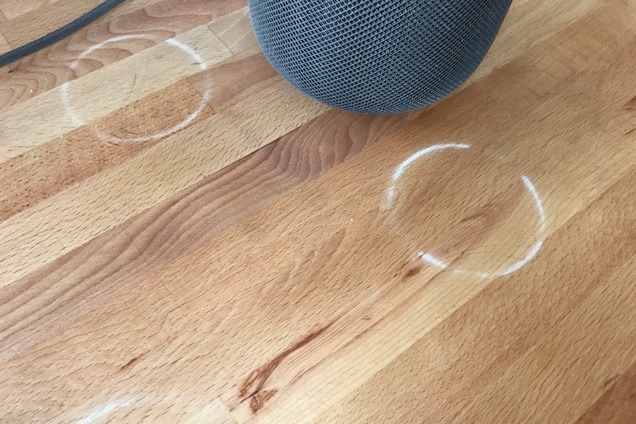HomePod's silicone bottom is causing rings on some finished wood surfaces [u]
Last updated
Apple's HomePod appears to be leaving white circles on some finished wood surfaces, but what specifically is causing it and any commonalities between the incidents both aren't clear yet. [Updated with Apple support info]
The phenomenon was first spotted by electronics evaluation site Wirecutter on Wednesday, and other sources from social media. it is manifesting from contact with "oiled" wood surfaces and the silicone ring on the bottom of a HomePod.
It is not appearing on all wood surfaces. AppleInsider's HomePod used for testing has been in a fixed location on a finished wood surface since Saturday, and no ring has developed.
AppleInsider spoke with a few professional woodworkers about the matter, and the consensus between them suggests a reaction between the silicone in the bottom ring of the HomePod, and a different form of silicone common in furniture polishes like Pledge. They called the reaction similar to the "fisheye" that can develop in some furniture as a result of chemical differences between the wood's finish and the polishes.
But, other than elevating the HomePod very slightly using a thin non-skid surface, they offered no easy and permanent solution for those suffering from the problem, other than stripping down the furniture, and replacing the finish with one lacking silicone.
Apple appears to be aware of the situation, an offers little in the way of advice. In an email to Wirecutter, Apple said that "the marks can improve over several days after the speaker is removed from the wood surface," and "try cleaning the surface with the manufacturer's suggested oiling method."
It appears that glass, granite, MDF plywood, polyurethane-sealed wood, and laminate furniture such as that found in Ikea are not affected by the problem — which makes sense if the problem is a reaction between different silicone mixes.
Update: Apple has published a support document elaborating on the cause of the issue and recommended steps.
"It is not unusual for any speaker with a vibration-dampening silicone base to leave mild marks when placed on some wooden surfaces," the webpage reads. "The marks can be caused by oils diffusing between the silicone base and the table surface, and will often go away after several days when the speaker is removed from the wooden surface. If not, wiping the surface gently with a soft damp or dry cloth may remove the marks. If marks persist, clean the surface with the furniture manufacturer's recommended cleaning process. If you're concerned about this, we recommend placing your HomePod on a different surface."
 Mike Wuerthele
Mike Wuerthele















 Amber Neely
Amber Neely
 Thomas Sibilly
Thomas Sibilly
 AppleInsider Staff
AppleInsider Staff
 William Gallagher
William Gallagher
 Malcolm Owen
Malcolm Owen
 Christine McKee
Christine McKee










134 Comments
This would be an excellent thread to get a new wood surface cleaning spray sponsor for the site. Just sayin’!
Put on a coaster, a mat or something that isolates it from your precious surface.
I doubt this escaped Apple's notice during the months of testing. More than a bit surprised they did not include a rubber mat/pad to isolate the speaker from the surface if desired (and it helps with vibration too), or just not use a silicone base to begin with.